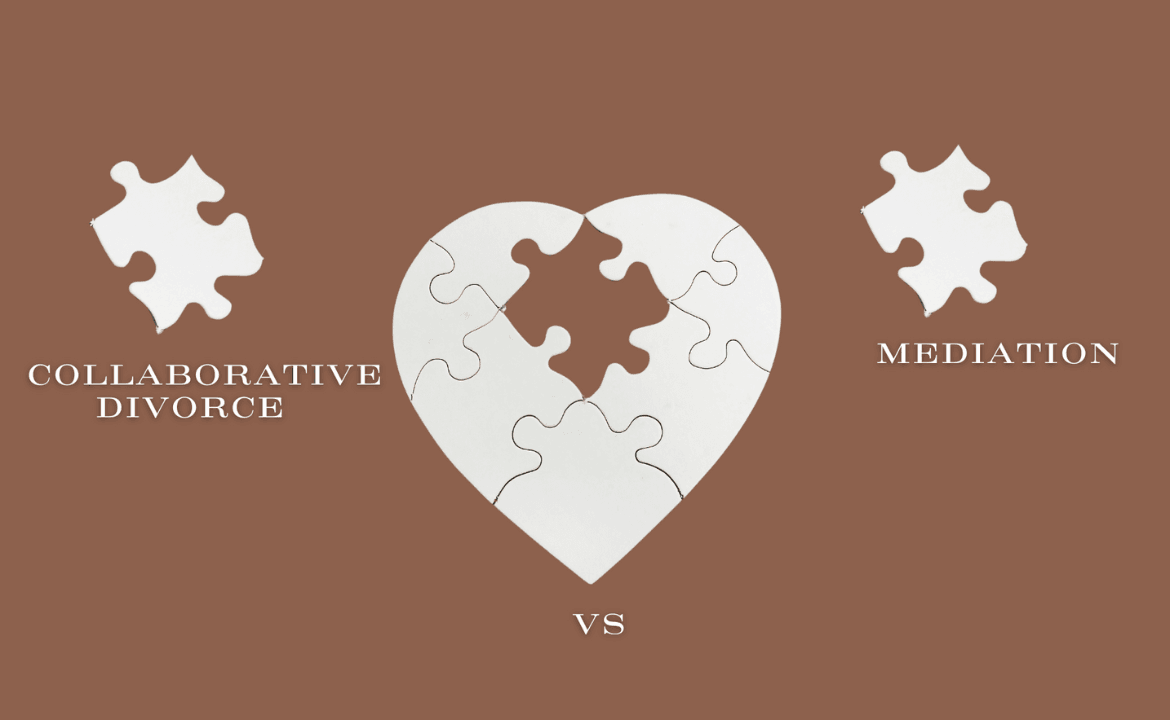This article explains and compares the procedures, benefits, and drawbacks of resolving your divorce through a collaborative divorce method or through the more conventional method of divorce mediation.
Either way, you will learn the advantages of both methods over having to litigate your case in divorce court.
This article also covers:
- An unbiased overview of the collaborative divorce and mediation processes.
- Comparisons of cost, confidentiality, and emotional impact between the two methods.
- Common Misconceptions about Collaborative Divorce and Mediation
- Common Fears Related to Collaborative Divorce and Mediation
Introduction
You’re not alone if you’re facing a divorce and worried about endless courtroom drama. Many couples are now turning to more mindful, less confrontational ways of ending a marriage, such as mediation and collaborative divorce. Especially when the parties are faced with difficult issues such as:
Both collaborative and mediated approaches are sound and smart alternatives to litigating your divorce. Both alternative dispute resolution methods can simplify the divorce process while reducing its emotional and financial impact on your life.
Should you be considering ending your marriage, understanding these alternative dispute-resolution approaches will help you make informed decisions during this challenging time.
Let us begin by first understanding each of these alternative methods to litigating your case in divorce court.
What is Collaborative Divorce?
Definition and Core Principles
Collaborative divorce is an approach in which both parties and their respective collaborative divorce lawyers commit to resolving their disputes outside the courtroom.
A Team Approach to Resolution
This method is voluntary and cooperative. In it, both spouses collaborate with divorce experts to reach a divorce settlement that works for everyone.
The collaborative approach is guided by the following core principles:
- Voluntary Participation: Collaborative divorce requires both parties to agree to participate in good faith and openly disclose all relevant information.
- Mutual Respect: All parties must commit to communicating respectfully and work together to reach a mutually acceptable settlement.
- Transparency: In a collaborative divorce, all information is shared transparently and honestly between the parties.
- Problem-Solving: Spouses are encouraged to find solutions that meet their respective needs rather than blaming the other spouse for the marriage’s breakdown.
- Commitment to Avoid Litigation: Participants commit not to take any disputes to court while engaging in the collaborative divorce process.
The Collaborative Divorce Process
The collaborative divorce process involves several joint sessions facilitated by collaborative lawyers and often supported by child specialists, financial professionals, and mental health professionals.
In the collaborative law process, the experts help address all aspects of the couple’s post-divorce future. Including child support and custody to property division and spousal support issues
Statistic: Success Rates: Collaborative divorce boasts a success rate exceeding 90%, indicating that the majority of couples reach amicable agreements without resorting to court proceedings.
Advantages and Disadvantages of Collaborative Divorce
Pros:
- Provides personalized support from a team of divorce experts, including their collaborative divorce lawyers, who may include divorce coaches and other divorce experts. All focus their energy on both spouse’s long-term well-being.
- Fosters creative solutions tailored to the specific needs of not only the spouses but also other core family members.
Cons:
- Higher costs associated with employing various specialists.
- If the collaboration fails, you might have to switch to traditional divorce litigation, which can complicate what may already have been achieved in the collabrative divorce process.

What is Divorce Mediation?
Definition and Core Principles
Mediation in divorce involves a neutral third party, known as a divorce mediator, who facilitates discussions and helps the parties reach an agreement amicably without providing legal advice. Mediation empowers the parties to make decisions about their family’s future. However, the mediator does not have any decision-making power.
Core principles of divorce mediation include:
- Impartiality: The mediator is a neutral party who does not represent any one individual or take sides.
- Confidentiality: All discussions and information shared during the mediation process are confidential.
- Self-determination: Both parties have control over the outcome and can make decisions shaped around their needs.
- Voluntariness: Participation in mediation is voluntary, and either party can withdraw at any time.
The Mediation Process
Divorce mediation typically involves several sessions in which the mediator works with both spouses to identify and resolve any divorce and post-divorce issues that need addressing.
Like collaborative divorce, this process covers all aspects of the separation, including child support, custody arrangements, and asset distribution. Once an agreement is reached, attorneys must review it before finalizing it in court.
Advantages and Disadvantages of Divorce Mediation
Pros:
- Typically, it incurs lower costs, helping parties save money compared to the collaborative divorce process.
- Generally, quicker resolution can be beneficial in an uncontested divorce scenario.
Cons:
- It may lack the legal guidance for handling complex cases, which could be critical for protecting legal rights.
- It is not suitable for high-conflict divorce situations where power imbalances are significant.
Statistic: Cost Efficiency: The average legal aid cost for resolving a private family dispute through mediation is approximately £500 per couple, compared to £4,000 for cases settled through the courts.
Comparing Collaborative Divorce to Mediation
Watch Los Angeles Family Law Attorney Raymond Hekmat Discuss Mediation and Collaborative Divorce:
Difference Between Collaborative and Ordinary Divorce Lawyers
Collaborative Divorce Attorney: Focuses on a cooperative, non-adversarial, and transparent process to reach an out-of-court settlement.
Ordinary Divorce Attorney: This type of attorney prepares for both negotiation and potential litigation, representing their client’s interests in court if necessary. It is typically more adversarial, less transparent, and a team approach.
Legal Tip
Cost Implications
Collaborative divorce can be pricier than mediation since it often involves a team of professionals, such as financial advisors and custody specialists, to support you. On the other hand, mediation usually costs less because it requires fewer professionals and sessions.
Confidentiality
Both processes require confidentiality. However, in collaborative divorce, certain confidential information may need to be shared with other team members, such as financial advisors or child specialists.
All discussions are kept strictly confidential in mediation between the parties, their lawyers, and the mediator.
Duration and Flexibility
While mediation might conclude more swiftly, but the collaborative process often provides more flexibility, which can be crucial for addressing a wider range of issues with different professionals.
Emotional and Psychological Impact
Collaborative divorce can be a more positive and supportive environment and rely heavily on child counseling and custody specialists.
Mediation provides a neutral environment, and lawyers often negotiate the different terms of the divorce with the mediator and then return to their clients to discuss their options on what can be emotionally charged issues such as child custody, visitation, child support, division of property, and spousal support.
Yet, the supportive setting of collaborative divorce is especially helpful for those who need extra emotional and psychological care, offering a more empathetic and team-driven approach to navigating the complexities of the process.
Choosing the Right Divorce Resolution Process
Factors to consider:
Choosing between collaborative divorce and mediation involves considering several factors, such as the amount of conflict in each process, your financial situation, privacy concerns, and, most importantly, the emotional needs and welfare of the children.
Both options aim to keep you out of court and offer less confrontational alternatives to traditional litigation.
Which one is best? It really depends on your unique situation. Here are some important points to consider.
- Both divorce methods prioritize the children’s well-being. In a collaborative divorce, a custody specialist can be involved to help address the children’s emotional needs and offer advice and practical ways to make the children’s transition smoother and less emotionally disruptive.
- In collaborative divorce, which is more focused on a win-win approach between the spouses and especially between the parents and their children, parents, through the help and presence of a child counselor, are advised of the danger of engaging in manipulative behaviors such as parent alienation.
Top Misconceptions about Collaborative Divorce and Mediation
Misconception: Both are legally binding from the get-go.
Reality: Collaborative divorce and mediation are both voluntary processes. They only become legally binding once you’ve reached a final agreement and approved it by the court. At first, they’re just a way to talk.
Misconception: You don’t need lawyers in either process.
Reality: While you don’t need your lawyer in either process, having one will ensure your rights are protected and the agreements reached are legally binding.
Misconception: Mediation is faster and cheaper than collaborative divorce.
Reality: Mediation can be faster and cheaper, but that’s not always true. A complex divorce will depend on the issues and how cooperative both sides are in reaching a resolution.
Misconception: Collaborative divorce is for all couples.
Reality: Collaborative divorce works for willing, open, and cooperative couples seeking resolution. But it won’t work in situations where there has been dishonesty, revenge, and domestic violence in the marriage.
Misconception: Mediation allows third-party decision-making.
Reality: Unlike arbitration, where a third-party arbitrator controls the process and makes the decisions, mediation involves a neutral facilitator who informs and guides the parties toward a resolution. All primary decision-making is left to the parties.
Top Fears in Collaborative and Divorce Mediation Process
Fear: Loss of control.
Reality: People worry they will be bullied or talked into settling their case against their will. However, both processes are meant to help everyone reach a good and fair agreement, and the parties involved always make the final decisions.
Fear: The case is too complex to be resolved by these methods
Reality: People worry these methods can’t handle complex cases with lots of assets or custody issues. But with the right experts and professional guidance, collaborative divorce and mediation can handle even the toughest negotiations.
Fear: Worried about unequal bargaining power.
Reality: Parties sometimes worry they will be overpowered or manipulated by a more dominant or articulate spouse. Both processes aim to create a level playing field, with professionals like lawyers and mediators ensuring the process is safe for all involved.
Fear: The process will fail and lead to litigation.
Reality: Parties worry that if collaboration or mediation breaks down, they’ll end up with long and costly litigation. Most cases get resolved through these alternative methods, and there are usually safeguards in place to keep the process moving until a settlement can be reached.
Fear: I will lose my privacy.
Reality: People worry about their personal matters becoming public during these informal processes. Unlike litigation and trial, which are public proceedings and result in public records, mediation and collaborative divorce are confidential, so your privacy and personal details are protected.
Frequently Asked Questions:
How Long After Mediation Is My Divorce Final?
The duration from mediation to finalizing a divorce depends on how long it takes to turn the mediation agreement into a formal settlement agreement, have it reviewed by the parties in consultation with their attorneys, and have it formally executed.
The final phase is for the court to review, approve, and turn the agreement into a court order. This process can take a few weeks to a few months.
When does a divorce mediation settlement become legally binding?
Divorce mediation agreements become legally binding when they are professionally drafted, signed by both parties, and approved by the court. The agreement then becomes the final order, which is sometimes referred to as a divorce decree.
How to prepare for divorce mediation?
Your first step is to consult with your lawyer and obtain a list of the documents they will likely need at the mediation. The list will likely include financial documents such as income and bank statements, tax returns, a list of your income and expenses, and property valuations.
Your lawyer may already have many documents, depending on how far you are in the litigation process. It is advisable to consult your financial advisor and lawyer to determine the probable financial range of spousal and child support.
Finally, prepare yourself emotionally to make important decisions about your post-divorce life. If you are already in counseling, you are ahead of the game. If not, consider seeking out supportive friends and family members.
Bottom Line
Choosing the right path for resolving your divorce, be it collaborative divorce or mediation, depends on your unique situation and needs.
A qualified divorce attorney can help you understand your options and help you make the best choices for you and your children.































